Introduction:
Effectiveness of the Business Strategies of British Airways will be evaluated in this report by applying appropriate models such as Ansoff matrix and more. Every company has a set of objectives and goals which it strives to achieve. Strategic management is all about compiling corporate and business strategies to help the company achieve its goals and objectives. Such business strategies help a company to enhance competitive advantage; whilst the absence of business strategies will result in a loss of competitiveness. This report has used a case study approach in which a range of strategic management models and tools have been used on a company. The selected company is British Airways. This is the largest airline in Britain and it is considered the flag-bearer airline of Britain. It carries about 145,000 customers every day to more than 200 destinations in 80 countries around the world (British Airways: 1, 2020). The company has more than 280 aircraft and it is likely to receive more than 100 new aircraft in 2020 (British Airways: 1, 2020). British Airways has employed about 45,000 expert and experienced employees who have been serving the company with utmost sincerity. This report has mainly been divided into two sections: the first section has applied different strategic management techniques and tools and evaluated how British Airways has applied them. The second part has critically evaluated the effectiveness of the applied tools in British Airways.
You may feel interested to read below blogs:
Internal External and Competitive Environment of Domino’s Pizza
Business strategies of Bang & Olufsen
Tourism strategies for Broadstairs coastal area
External Environmental Analysis of InterContinenal (IHG) Hotels and Resorts
External and Internal Environment Analysis of Nando’s
Ansoff’s Growth Matrix Of British Airways:
Ansoff’s growth matrix is the theory that refers to the ways of achieving growth in an organization (Loredana, 2016). The theory has four steps such as market penetration, market development, product development, and last one is diversification.
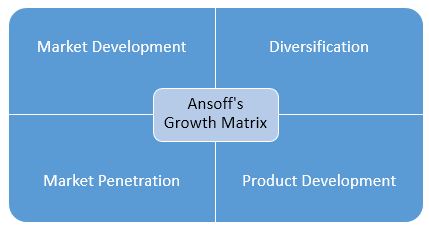
The market penetration stage is the process in which a company takes initiative to foster sales of existing products and services in the existing market. Market development is a way of targeting new markets with existing products in order to increase revenue (Loredana, 2016). Product penetration indicates the process of developing present products or innovating new products to meet customers’ demands and increase sales to become more profitable. Diversification is the growth option in which companies enter into new markets with new products or services to capture the customers of new markets and sell new products in order to have outstanding revenue (Dawes, 2018). The drawback of the model is that the model is very old and simple which is not effective for the advanced business world because the model is based on products and markets (Loredana, 2016).
British Airways also follow some steps of the theory to ensure their growth and generate higher revenue. The company uses a market penetration strategy for the 80 countries they have services and foster its sales in the 200 destinations that the company covers (British Airways: 1, 2020). British Airways increase sales in the current market through advertising, sales promotion, different competitive strategies and personal sales furthermore invest a huge amount in sales and marketing to ensure a higher sales rate. The company also apply product development to retain customers and get new ones. For instance, British Airways’ new aircraft, Airbus A380 and Boeing 787 are the newest innovations in aircraft engineering and cabin design (British Airways: 2, 2020). Ergonomically designed seats of the aircraft ensure comfort for customers and a gentle light system makes the night a day.
Porter’s Generic Strategies of British Airways:
Porter’s generic strategies are the theory through which organizations can differentiate their business from competitors and stay ahead in the competition (Wicker et al., 2015). British Airways follows the theory to make its position stronger among competitors in the global aviation industry.
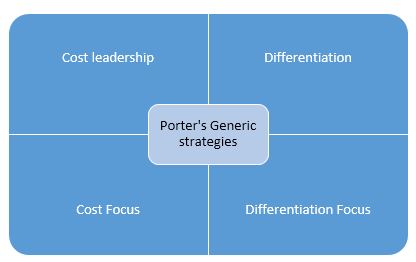
Porter’s generic strategies have four segments: Cost leadership, differentiation, focus and differentiation focus. Cost leadership is the competitive advantage in which an organization provides the cost-efficient services to customers to retain them and increase sales (Viltard, 2017). Differentiation refers to the competitive advantage in which companies provide unique and different services than their competitors and do not consider the price, and customers pay higher prices for the quality of their service (Ouma, and Oloko, 2017). Cost Focus indicates the process of fulfilling customers’ core demand that competitors are unable to meet, considering the price. Focus differentiation means fulfilling customers’ unfulfilled demands without considering the price (Rizea, 2015). The drawback of the model is companies need to select two strategies because one strategy may not work to strengthen competitive advantage.
British airways apply differentiation strategies among the strategies of porter’s generic model. The airline provides a unique and standard customer experience and does not consider the price of its services. For instance, new aircraft of British Airways such as Airbus A380 provide the latest aircraft services such as outstanding lighting interiors and relaxed seat facilities that deliver an outstanding experience to the customers (British Airways: 2, 2020). These types of services differentiate British Airways from its competitors.
Porter’s Five Forces Model of British Airways:
This model is applied to evaluate the competition in the market in which companies execute their business and can take significant initiatives to be stronger in the competition (Mathooko, and Ogutu, 2015). Porter’s five forces model has five stages.
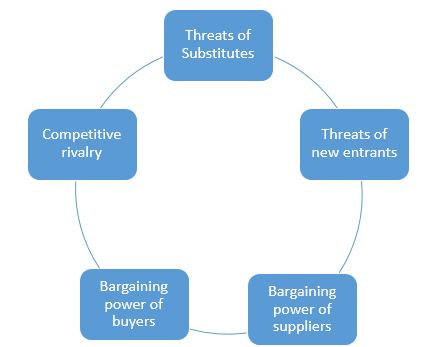
Threats of new entrants indicate the power of new entries for companies and they become aware of handling the threat (Kharub, and Sharma, 2017). Threats of substitutes refer to the availability of substitutes that affect sales of an organization and organizations can enhance quality to beat the substitutes (Takata, 2016). The bargaining power of suppliers shows how much power the suppliers are to dominate the business of organizations. The bargaining power of buyers shows the power of buyers to influence the pricing strategies of the business, and companies become aware of customers’ expectations (Zhao et al., 2016). Competitive rivalry refers to the level of competition in the market in which companies operate the business and shows their business steps that make them strong (Takata, 2016). The drawback of the model is, it is just an overview of the competition in a market which should provide a concise picture of the competition.
British Airways applies the five forces model to know about the competition of the targeted market and become aware of the competition of the market. It is not possible for new entrants to beat British Airways because they invest £6.5bn for customers, which helps them to maintain their outstanding image in customers’ minds (British Airways: 3, 2020). Suppliers have a great influence on the airlines because there are fewer suppliers who produce mechanisms with the best technology and quality. Threats of substitutes are also high because trains, buses, ships and other substitutes are available at lower costs therefore customers select them to save money. Customers have high bargaining power because they have other airlines to choose within lower costs, and they bargain for the price of British Airways. Easy Jet, Jet2, Virgin, Delta, Monarch Air Group, United Airlines, American Airline’s etcetera are the competitors of British Airways (OAG Aviation Worldwide Limited, 2020). It faces high competitive rivalry because competitors often provide attractive offers and discount to the customers.
Value Chain Analysis of British Airways:
Value chain analysis indicates the set of activities which are completed to create a value chain through a company and strengthen its competitive advantage (Bammann, 2019). The segments of value chain analysis are inbound logistics, outbound logistics, operations, service and marketing and sales (Whiteet al., 2018). A company delivers value for their customers by applying this model and ensuring a stronger competitive position. The drawback of the model is, companies may lose its overall strategy and vision because operations are broken down into so many segments (Purcell al., 2017).
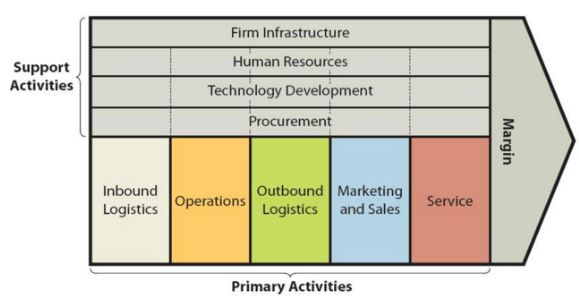
British Airways uses the latest aircraft with the latest technologies, and the aircraft has all types of facilities that gratify people; therefore customers purchase the services of British Airways at a higher price than other airlines. The company ensures outstanding customer experience and customers get value for their money, which is why customers are ready to bear the cost of British Airways’ tickets which reflects the value chain model. British Airways becomes highly profitable by following the stages of value chain analysis. The company maintain strong relationships with the suppliers that help them to make sure the supply of mechanisms that the company needs for their aircraft and it indicates inbound logistics of the value chain. The operations stage of British Airways is ensuring the security of customers’ luggage, check-in-services, ticket booking and other services (Airways, 2017). The airline distributes its tickets through its official website, online travel agencies, offline travel agencies and their offices. All these distribution channels makes sure that customers easily get the tickets. British Airways deliver its marketing message to customers through print and media advertising, events and experiences, sales promotions, direct marketing and public relations and these reflect the marketing and sales segment of the value chain. British Airway arranges training and development programme for employees, deliver a flexible workplace and protect employees’ right to keep them motivated in order to ensure profitability and productivity for the company (Airways, 2017). It reflects the support activities of the airline. The company ensures post-sale services such as handling complaints, solving customers’ problems and others that strengthen competitive advantage. The procurement of British Airways is managed by themselves, and they build constructive relations with suppliers and buy standard mechanisms from them.
Experience Curve of British Airways:
The experience curve is the process of reducing costs, overcoming problems and attaining targeted growth by utilizing the experience of employees (Wei, Smith, and Sohn, 2017). This model assists organizations to be successful in reducing costs because the model ensures that employees operate all the operations by utilizing their experiences. It makes sure outstanding outcomes of the operations and companies become stronger among the competitors. The drawback of the experience curve is that the model is not effective in this advanced business world.
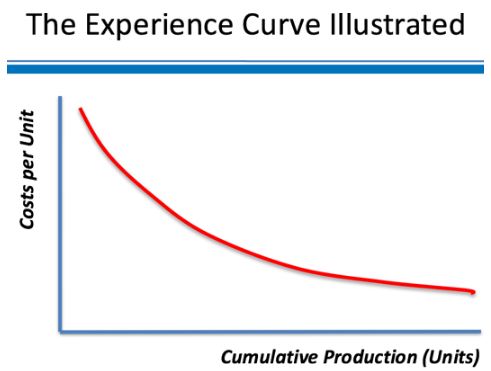
British Airways have faith that employees are the key resource of the company, and this thought influences the employees’ gratification. The thought encourages the company to provide a learning and development programme for employees to ensure continuous development of their employees, which enhances the skills and experiences of the employees. Therefore, employees of British Airways are able to deliver the flawless results for all operations to the company, which develops the quality of the services of company. Protection of employees’ rights and a flexible workplace make the employees highly gratified. The training and development program of British Airways provides the facility to develop employees’ careers that makes them awful to the company, and employee retention increases in British Airways, which causes a higher experience for the employees. Employees become highly experienced because of working in British Airways for years, and the employees become able to deliver outstanding services to the customers.
The Effectiveness of the Business Strategies of British Airways:
Market penetration assists British Airways to foster its sales: Market penetration is the strategy that helps companies to increase sales in the current market. British Airways has business in 80 countries of the world and market penetration assists them to foster their sales in the countries where they have services (British Airways: 1, 2020). The company has become capable of encouraging customers in order to adopt its services quickly in the market. British Airways uses different types of sales promotion, different competitive strategies, personal sales, marketing and other ways that help the company to foster its growth within the current market. Because of market penetration strategies, the sales of the airline remain high because customers are encouraged to buy the services of the company. Sometimes the company use an aggressive pricing strategy to foster the sales of their services in the current market (Karami, 2017). Market penetration also assists British Airways in maintaining its leading position in the market, and it makes its position stronger. As a result, new companies do not get the courage to enter in the market because they see that British Airways has outstanding demand in the market and it is tough to attract customers from the airline.
Product development helps British Airways to develop their services from competitors: Product development is the way of developing new products and services or inventing new products or services that makes the services of an organization different from competitors, and customers become satisfied after getting the developed services. British Airways conducts product development and enhance the quality of its services by developing the current services or inventing new ideas to deliver better services to the customers (Karami, 2017). It brings higher profit because customers become gratified with the services and re-purchase the services of British Airways. Because of product development, British Airways has become capable of maximizing the satisfaction of customers the reason that they get outstanding services. The company invests £6.5bn for customers, which assists the company to maintain their demand and create an outstanding image in customers’ minds by providing the best services (British Airways: 3, 2020). By delivering developed services, British Airways achieved goodwill for their company.
Differentiation strategy strengthens the competitive advantage of British Airways: Differentiation is the process in which companies produce exclusive products or deliver exclusive services that competitors do not provide, and the price of the products or services is higher. British Airways applies this strategy and delivers exclusive services to the customers that help the company to compete in the market strongly (Ustaomer, Durmaz, and Lei, 2015). For instance, British Airways use one of the latest airbus A380S that delivers exclusive customer experiences such as double beds, fancy onboard bars, tail camera, massive first-class bathrooms including showers, etcetera (The Luxury Travel Expert, 2019). The unique aircraft delivers customers the best aeroplane experience; therefore, British Airways do not need to compete with a lower-cost strategy. The company become able to increase brand loyalty through delivering differentiated services. It also minimizes the threats of new entrants and substitutes for the company. Because of the competitive advantage, British Airways became capable of generating 13.3 billion British pounds in revenue in 2019 (Statista, 2020).
Porter’s five forces helped British Airways to become aware of the competition and take steps to compete strongly: It is found from the analysis that threats of new entrants is lower in front of British Airways because it is one of the best airlines in the world and have great outstanding demand of their services across the world. The company maintain the quality of their services to hold on to its leading position and keep the threat of new entrants lower (Coller, Helms Mills, and Mills, 2016). Suppliers have great power to dominate the business of British Airways therefore, the company maintain a constructive relationship with them. As a result, they become able to maintain the flow of mechanisms and continue providing the best services with the latest aircraft. The bargaining power of customers is high because they have so many substitutes, and British Airways provide the best services to retain the customers and ensure that they will not switch services of British Airways. The company has become aware of the higher competitive rivalry in the aviation market and has taken different types of effective strategies to maintain its position in the industry.
Value chain analysis assists British Airways in delivering value for customers’ money and time: The latest aircraft British Airways use delivers exclusive customer services, and the company creates value for customers’ money and time (Lange et al., 2015). Customers pay premium prices for exclusive services and it makes British Airways profitable. By building constructive relationships with suppliers help British Airways to maintain the flow of raw materials and continue providing the best services for customers. The company do all the operations carefully, such as ticket booking, check-in, and ensuring the security of customers’ luggage, that makes customers loyal to the company. British Airways distribute tickets through travel agents, website and online; therefore, customers get the tickets without any problem, which encourages them to buy the services (Madar, 2015). Sales promotion, direct marketing and other marketing strategies ensure a high sales rate for British Airways. The company’s training and development programme enhance the capability of employees to make sure that the quality of services is maintained carefully. All these steps help the company to compete strongly in the market and become highly profitable.
Experience curve helps the company to ensure flawless outcome: By using the experience curve, British Airways become capable of retaining employees for a long time which enhances their experiences (Tckhakaia, Cabras, and Rodrigues, 2015). As a result, employees become capable of solving all type of problems and avoid many problems that create problems in their operations. The employees ensure that customers do not face any problems while travelling, and it increases customers satisfaction that also fosters the sales of the company.
Recommendations:
British Airways should also look for diversification strategies which will provide the company competitive advantage. The company should focus on cost leadership strategies apart from differentiation because people’s purchasing power will decrease during post-COVID 19 period, and thus customers will look for cheap flights. British Airways should focus on suppliers who supply critical and sensitive items.
Conclusion:
A wide range of models and theories have been applied to the above analysis and evaluation. Ansoff’s Growth Matrix offers four strategic directions on how a company should make its strategies regarding product and service offerings. The report revealed that British Airways applies product development and market penetration strategies which help the company to retain existing customers and to attract new ones. Porter’s Generic strategies offer a company different options for being competitive based on the nature of the business. The report has found that British Airways follows differentiation strategies to offer customers a unique value proposition and state-of-the-art services and benefits. This strategy worked really well for the company. However, it is suggested that the company should also focus on the cost leadership approach for a segment of its customers due to the economic slowdown in the post-COVID-19 period. It has been found in the report that the threat of new entrants is low due to the heavy investment nature of the industry. However, it has been found that the bargaining power of suppliers is high because the supplies are sensitive. The report has also found that industry rivalry is high because there are many alternative airline companies around the globe. The value chain model has revealed that British Airways always try to add value in every stage of the value chain model to enhance customer satisfaction. The report has also revealed that experience of operating airlines for more than 100 years has provided huge benefits in terms of experience curve, which explains that the company is highly efficient.
Reference List:
British Airways: 1, 2020. BRITISH AIRWAYS FACTSHEET. Retrieved from: https://mediacentre.britishairways.com/factsheets/details/86/Factsheets-3/33 [Assessed on: 22 May 2020]
British Airways: 2, 2020. Our new aircraft. Retrieved from: https://www.britishairways.com/en-gb/information/flight-information/our-aircraft [Assessed on: 22 May 2020]
British Airways: 3, 2020. BRITISH AIRWAYS’ INVESTMENT FOR CUSTOMERS. Retrieved from: https://mediacentre.britishairways.com/factsheets/details/86/Factsheets-3/43 [Assessed on: 22 May 2020]
OAG Aviation Worldwide Limited, 2020. British Airways and easyJet perform well against global competition. Retrieved from: https://www.oag.com/pressroom/british-airways-and-easyjet-perform-well-against-global-competition [Assessed on: 22 May 2020]
Purcell, S.W., Crona, B.I., Lalavanua, W. and Eriksson, H., 2017. Distribution of economic returns in small-scale fisheries for international markets: a value-chain analysis. Marine Policy.
Statista, 2020. British Airways – worldwide revenue 2010-2019. Retrieved from: https://www.statista.com/statistics/264296/british-airways-worldwide-revenues-since-2006/ [Assessed on: 23 May 2020]
Tutor 2u, 2018. The Experience Curve. Retrieved from: https://www.tutor2u.net/business/reference/the-experience-curve [Assessed on: 22 May 2020]
The Luxury Travel Expert, 2019. Top 10 most exciting features of the Airbus A380. Retrieved from: https://theluxurytravelexpert.com/2019/01/14/exciting-features-a380/ [Assessed on: 23 May 2020]
Research Methodology, 2016. British Airways Value Chain Analysis. Retrieved from: https://research-methodology.net/british-airways-value-chain-analysis/ [Assessed on: 22 May 2020]
